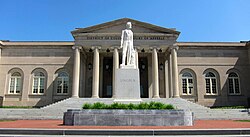Washington City Hall
|
District of Columbia City Hall
|
|
 |
|
| Location | 451 Indiana Avenue NW Washington, D.C. |
|---|---|
| Coordinates | 38°53′43″N 77°1′4″W / 38.89528°N 77.01778°WCoordinates: 38°53′43″N 77°1′4″W / 38.89528°N 77.01778°W |
| Built | 1820 |
| Architectural style | Neoclassical |
| NRHP reference # | 66000857 |
| Significant dates | |
| Added to NRHP | 15 October 1966 |
| Designated NHL | 19 December 1960 |
District of Columbia City Hall, also known as "Old City Hall" and the "District of Columbia Courthouse", is an historic building at Judiciary Square in downtown Washington, D.C. facing Indiana Avenue. Originally built for the offices of the D.C. municipal government, the District's City Hall was subsequently used as a Federal courthouse, and was the scene of several notable criminal trials including those of three accused presidential assassins. The building was declared a National Historic Landmark in 1960. It now houses the District of Columbia Court of Appeals.
The government of the City of Washington held a competition for the design of a new municipal building in 1818. George Hadfield, who had supervised construction of the United States Capitol from October 1795 to May 1798, submitted a design for a new city hall, but it was judged to be too costly. Hadfield eventually won the competition in 1820 with a revised version of his original plan, and construction began in August. The offices of the city government moved into the building in 1822. However, a lack of funds and other problems hindered construction and the building would not be completed in its entirety until 1849.
According to the NRHP nomination for the adjacent, compatibly-designed United States Court of Military Appeals Building (1910), the city hall building's south side plan is attributed to George Hadfield, but the north side plan is attributed to Robert Mills.
To raise funds needed to finish the building, the city leased out space during construction to other federal government offices. Tenants included the U.S. Circuit Court and the Recorder of Deeds office, then headed by noted black leader and abolitionist Frederick Douglass, (1818-1895), who also later served as U.S. Marshal for the District. Following passage of the District of Columbia Compensated Emancipation Act in 1862, the Old City Hall was used to process payments to slaveholders.
...
Wikipedia



